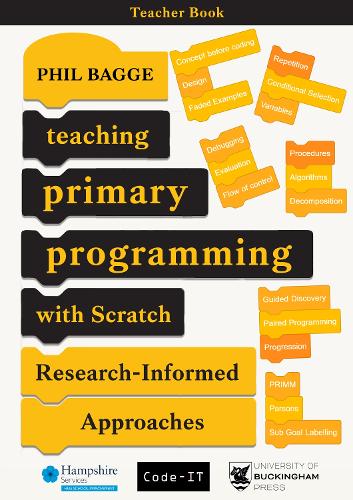
Teaching Primary Programming with Scratch Teacher Book: Research-Informed Approaches
(Paperback)
Publishing Details
Teaching Primary Programming with Scratch Teacher Book: Research-Informed Approaches
By (Author) Phil Bagge
Legend Press Ltd
The University of Buckingham Press
30th November 2022
United Kingdom
Classifications
Primary and Secondary Educational
Non Fiction
Programming and scripting languages: general
372.340440941
Physical Properties
Paperback
112
Width 205mm, Height 254mm
500g
Description
Who is this book written for
This book is aimed at KS2 (grade 2-5 in US) primary (elementary) teachers and secondary teachers who use Scratch to teach programming.
Why was it written
To introduce a range of research supported programming methodology that works in the classroom in a way that non-specialist teachers can put it into action in their own classrooms. To share the joy and creativity of block-based programming through knowledge that leads to greater progress and higher pupil agency.
Does it include a scheme of work
There are four companion books to this which include fully resourced research informed modules to use with primary / elementary classes.
- Scratch IT- Teaching Primary Programming in Year 3
- Scratch IT- Teaching Primary Programming in Year 4
- Scratch IT- Teaching Primary Programming in Year 4
- Scratch IT- Teaching Primary Programming in Year 6
Is This Book Still Useful If You Choose Other Resources To Teach
Yes, research-informed methods are always useful in improving the knowledge you choose to teach, the order or progression you choose to teach it in and the methodologies and support strategies you choose to use. This book is written to aid the scheme but also includes many other strategies and methodologies that you might find useful that are not fully utilised in the scheme.
About the series
These books, classroom-tested and perfected by Phil Bagge through his website code-it.co.uk and published in conjunction with Hampshire Inspection and Advisory Service (HIAS), aid teachers in providing Key Stage 2 pupils with an exciting and challenging programming curriculum.
They can be used to supplement existing programming modules or as a complete KS2 computer science program of study. They contain a series of programming projects that gradually introduce pupils to algorithm design and evaluation, generalisation and decomposition. Pupils will learn how to use sequence, repetition, selection, variables and procedures through becoming creators of a wide variety of programming projects from a range of different genres.
In addition, there are also two home learning books that have been devised for children to learn programming in a home learning environment.
The Scratch programming language, widely recognised in schools, is freely accessible online or as a download and is the ideal place to begin programming.
